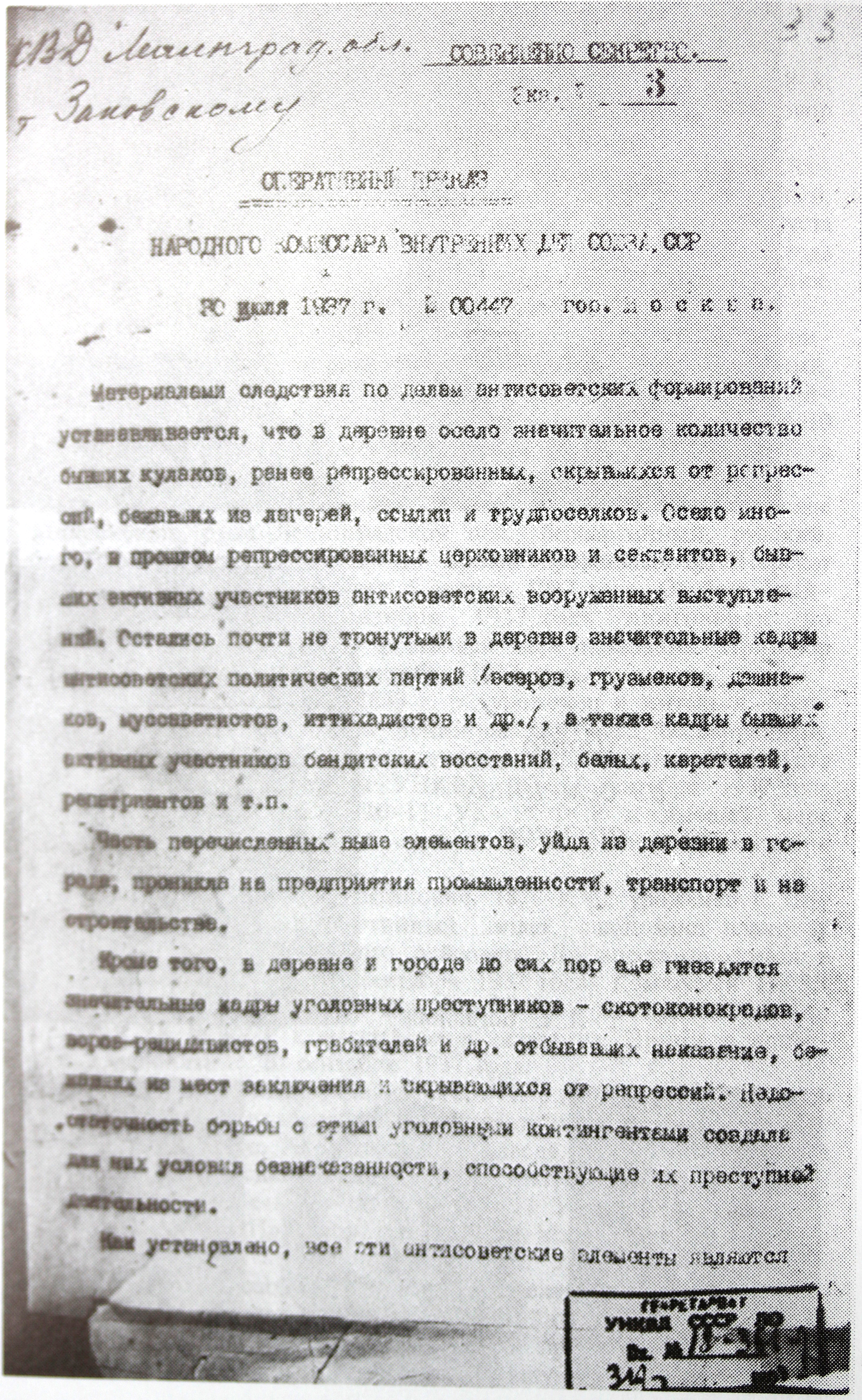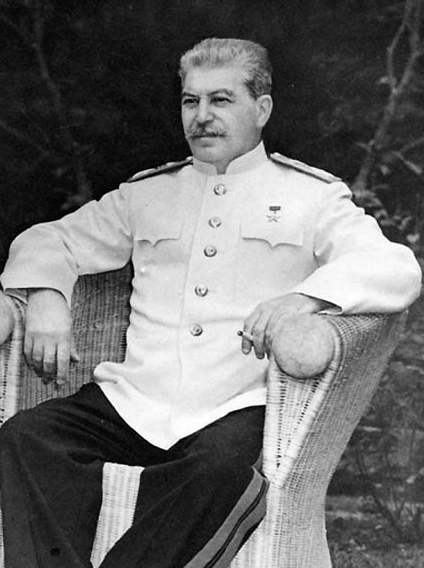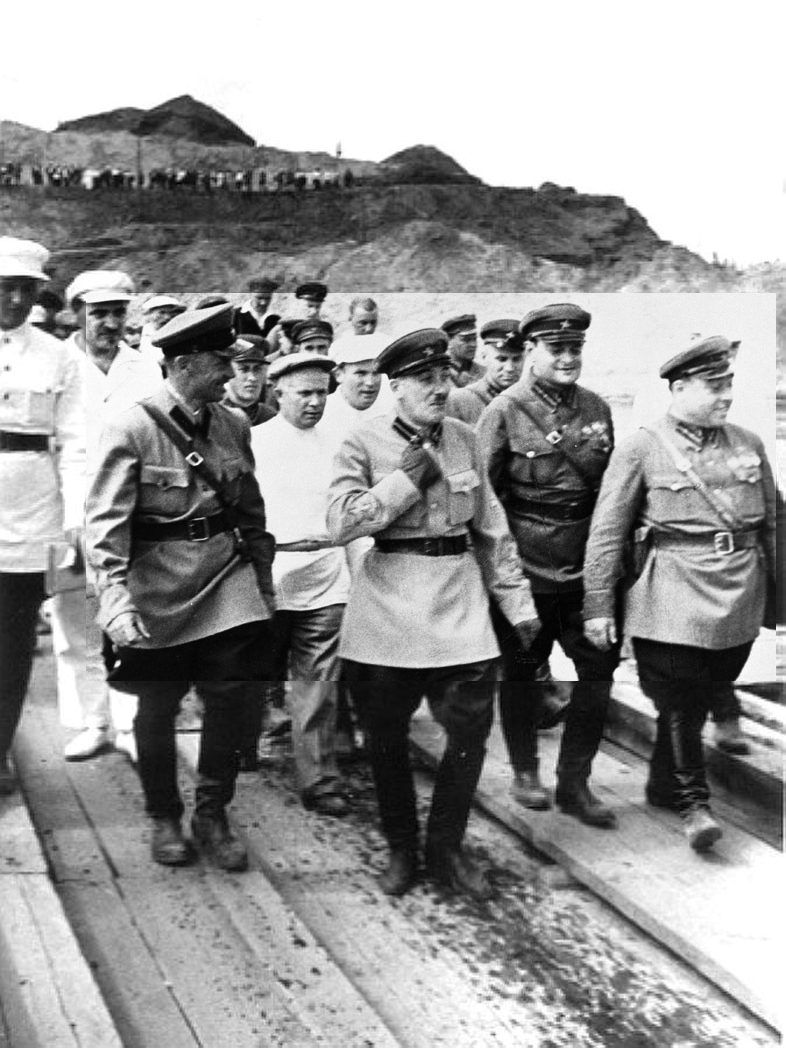|
Matvei Pogrebinsky
Matvei S. Pogrebinsky (1892-1937) was a Russian revolutionary. In the 1930s he was responsible for setting up many orphanages and communes for delinquent children, and was the man who founded the Bolshevo Commune. He was the inspiration for the very popular Soviet film, ''Putevka v Zhizn'' ("Path to Life") in 1931 . He was the head of the NKVD in the Gorky Oblast (Nizhny Novgorod) and in 1937 committed suicide in order to avoid "participation in lawlessness, as his suicide letter reveals."(Medvedev, Roy Alexander. ''Let History Judge: The Origins and Consequences of Stalinism''. 1989, Columbia University Press, Page 426) In 1954 the scholar Alexander Orlov explained Pogrebinsky's suicide in a similar fashion, "Squeezed between the relentless discipline of the party and pangs of conscience, Pogrebinsky saw in suicide the only way out". His suicide was similar to many officials during the Great Terror, as revolutionaries who could not deal with the terror of Stalinism saw suicide ... [...More Info...] [...Related Items...] OR: [Wikipedia] [Google] [Baidu] |
Bolshevo Commune
Bolshevo () is the area of the city of Korolyov (an industrial city in Moscow Oblast, Russia, well known as the cradle of Soviet and Russian space exploration), the historical part of it. It was founded as an independent town in 1573. It is best known as giving the name of Bolshevo railway station which is located on Yaroslavsky suburban railway line, Moscow. In 2019 the exhibition ''Station Bolshevo: the crossroads of fate, 1939'' commemorated a notebook of the poet Marina Tsvetaeva which contains translations she made of 12 poems by Mikhail Lermontov Mikhail Yuryevich Lermontov ( , ; rus, Михаи́л Ю́рьевич Ле́рмонтов, , mʲɪxɐˈil ˈjʉrʲjɪvʲɪtɕ ˈlʲerməntəf, links=yes; – ) was a Russian Romanticism, Romantic writer, poet and painter, sometimes called ... into French whilst in Bolshevo. A second notebook belonging to Sergei Durylin was also featured. This contained chapters from his book ''In His Own Corner'' which covered his st ... [...More Info...] [...Related Items...] OR: [Wikipedia] [Google] [Baidu] |
NKVD
The People's Commissariat for Internal Affairs (, ), abbreviated as NKVD (; ), was the interior ministry and secret police of the Soviet Union from 1934 to 1946. The agency was formed to succeed the Joint State Political Directorate (OGPU) secret police organization, and thus had a monopoly on intelligence and state security functions. The NKVD is known for carrying out political repression and the Great Purge under Joseph Stalin, as well as counterintelligence and other operations on the Eastern Front of World War II. The head of the NKVD was Genrikh Yagoda from 1934 to 1936, Nikolai Yezhov from 1936 to 1938, Lavrentiy Beria from 1938 to 1946, and Sergei Kruglov in 1946. First established in 1917 as the NKVD of the Russian SFSR, the ministry was tasked with regular police work and overseeing the country's prisons and labor camps. It was disbanded in 1930, and its functions dispersed among other agencies before being reinstated as a commissariat of the Soviet Union ... [...More Info...] [...Related Items...] OR: [Wikipedia] [Google] [Baidu] |
Nizhny Novgorod
Nizhny Novgorod ( ; rus, links=no, Нижний Новгород, a=Ru-Nizhny Novgorod.ogg, p=ˈnʲiʐnʲɪj ˈnovɡərət, t=Lower Newtown; colloquially shortened to Nizhny) is a city and the administrative centre of Nizhny Novgorod Oblast and the Volga Federal District in Russia. The city is located at the confluence of the Oka (river), Oka and the Volga rivers in Central Russia, with a population of over 1.2 million residents, up to roughly 1.7 million residents in the urban agglomeration. Nizhny Novgorod is the List of cities and towns in Russia by population, sixth-largest city in Russia, the Volga#Biggest cities on the shores of the Volga, second-most populous city on the Volga, as well as the Volga Federal District. The city is located 420 kilometers (260 mi) east of Moscow. It is an important economic, transportation, scientific, educational and cultural centre in Russia and the vast Volga-Vyatka economic region, and the main centre of river tourism in Russia. In the his ... [...More Info...] [...Related Items...] OR: [Wikipedia] [Google] [Baidu] |
Great Purge
The Great Purge, or the Great Terror (), also known as the Year of '37 () and the Yezhovshchina ( , ), was a political purge in the Soviet Union that took place from 1936 to 1938. After the Assassination of Sergei Kirov, assassination of Sergei Kirov by Leonid Nikolaev in 1934, Joseph Stalin launched a series of show trials known as the Moscow trials to remove suspected party dissenters from the Communist Party of the Soviet Union, especially those aligned with the Bolsheviks, Bolshevik party. The term "great purge" was popularized by the historian Robert Conquest in his 1968 book ''The Great Terror (book), The Great Terror'', whose title was an allusion to the French Revolution's Reign of Terror. The purges were largely conducted by the NKVD (People's Commissariat for Internal Affairs), which functioned as the Ministry of home affairs, interior ministry and secret police of the USSR. Starting in 1936, the NKVD under chief Genrikh Yagoda began the removal of the central pa ... [...More Info...] [...Related Items...] OR: [Wikipedia] [Google] [Baidu] |
Stalinism
Stalinism (, ) is the Totalitarianism, totalitarian means of governing and Marxism–Leninism, Marxist–Leninist policies implemented in the Soviet Union (USSR) from History of the Soviet Union (1927–1953), 1927 to 1953 by dictator Joseph Stalin and in Satellite state#Post-World War II, Soviet satellite states between 1944 and 1953. Stalinism included the creation of a Rule of man, one man totalitarian police state, rapid Industrialization in the Soviet Union, industrialization, the theory of socialism in one country, forced Collective farming, collectivization of agriculture, intensification of the class struggle under socialism, intensification of class conflict, a Joseph Stalin's cult of personality, cult of personality, and subordination of the interests of foreign Communist party, communist parties to those of the Communist Party of the Soviet Union, which Stalinism deemed the leading Vanguardism, vanguard party of communist revolution at the time. After Stalin's dea ... [...More Info...] [...Related Items...] OR: [Wikipedia] [Google] [Baidu] |
Purge
In history, religion and political science, a purge is a position removal or execution of people who are considered undesirable by those in power from a government, another, their team leaders, or society as a whole. A group undertaking such an effort is labeled as purging itself. Purges can be either nonviolent or violent, with the former often resolved by the simple removal of those who have been purged from office, and the latter often resolved by the imprisonment, exile, or murder of those who have been purged. Characteristics The Shanghai massacre of 1927 in China and the Night of the Long Knives of 1934 in Nazi Germany, in which the leader of a political party turns against a particular section or group within the party and kills its members, are commonly called "purges". Mass expulsions of populations on the grounds of racism and xenophobia, such as the deportation of the Crimean Tatars in the Soviet Union, are not. Though sudden and violent purges are notable, most purge ... [...More Info...] [...Related Items...] OR: [Wikipedia] [Google] [Baidu] |
Russian Revolution (1917)
The Russian Revolution was a period of political and social change in Russia, starting in 1917. This period saw Russia abolish its monarchy and adopt a socialist form of government following two successive revolutions and a civil war. It can be seen as the precursor for other revolutions that occurred in the aftermath of World War I, such as the German Revolution of 1918–1919. The Russian Revolution was a key event of the 20th century. The Russian Revolution was inaugurated with the February Revolution in 1917, in the midst of World War I. With the German Empire inflicting defeats on the front, and increasing logistical problems causing shortages of bread and grain, the Russian Army was losing morale, with large scale mutiny looming. Officials were convinced that if Tsar Nicholas II abdicated, the unrest would subside. Nicholas stepped down, ushering in a provisional government led by the Duma (parliament). During the unrest, Soviet councils were formed by locals in ... [...More Info...] [...Related Items...] OR: [Wikipedia] [Google] [Baidu] |
NKVD Officers
The People's Commissariat for Internal Affairs (, ), abbreviated as NKVD (; ), was the interior ministry and secret police of the Soviet Union from 1934 to 1946. The agency was formed to succeed the Joint State Political Directorate (OGPU) secret police organization, and thus had a monopoly on intelligence and state security functions. The NKVD is known for carrying out political repression and the Great Purge under Joseph Stalin, as well as counterintelligence and other operations on the Eastern Front of World War II. The head of the NKVD was Genrikh Yagoda from 1934 to 1936, Nikolai Yezhov from 1936 to 1938, Lavrentiy Beria from 1938 to 1946, and Sergei Kruglov in 1946. First established in 1917 as the NKVD of the Russian SFSR, the ministry was tasked with regular police work and overseeing the country's prisons and labor camps. It was disbanded in 1930, and its functions dispersed among other agencies before being reinstated as a commissariat of the Soviet Union in 1934. ... [...More Info...] [...Related Items...] OR: [Wikipedia] [Google] [Baidu] |
1892 Births
In Samoa, this was the only leap year spanned to 367 days as July 4 repeated. This means that the International Date Line was drawn from the east of the country to go west. Events January * January 1 – Ellis Island begins processing Immigration to the United States, immigrants to the United States. February * February 27 – Rudolf Diesel applies for a patent, on his compression ignition engine (the Diesel engine). * February 29 – St. Petersburg, Florida is incorporated as a town. March * March 1 – Theodoros Deligiannis ends his term as Prime Minister of Greece and Konstantinos Konstantopoulos takes office. * March 6–March 8, 8 – "Exclusive Agreement": Rulers of the Trucial States (Abu Dhabi, Dubai, Sharjah, Ajman, Ras al-Khaimah and Umm al-Quwain) sign an agreement, by which they become ''de facto'' British protectorates. * March 11 – The first basketball game is played in public, between students and faculty at the Springfield YMCA before 200 spectators. The ... [...More Info...] [...Related Items...] OR: [Wikipedia] [Google] [Baidu] |
1937 Deaths
Events January * January 1 – Anastasio Somoza García becomes President of Nicaragua. * January 5 – Water levels begin to rise in the Ohio River in the United States, leading to the Ohio River flood of 1937, which continues into February, leaving 1 million people homeless and 385 people dead. * January 15 – Spanish Civil War: The Second Battle of the Corunna Road ends inconclusively. * January 23 – Moscow Trials: Trial of the Anti-Soviet Trotskyist Center – In the Soviet Union 17 leading Communists go on trial, accused of participating in a plot led by Leon Trotsky to overthrow Joseph Stalin's regime, and assassinate its leaders. * January 30 – The Moscow Trial initiated on January 23 is concluded. Thirteen of the defendants are Capital punishment, sentenced to death (including Georgy Pyatakov, Nikolay Muralov and Leonid Serebryakov), while the rest, including Karl Radek and Grigory Sokolnikov are sent to Gulag, labor camps and later murdered. They were i ... [...More Info...] [...Related Items...] OR: [Wikipedia] [Google] [Baidu] |








